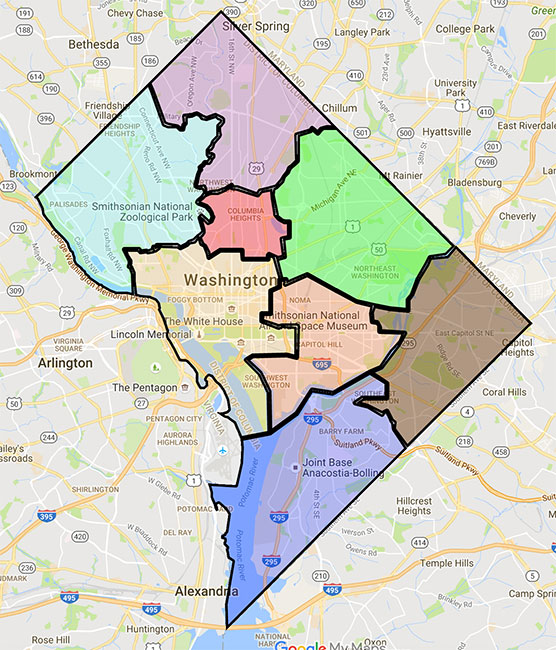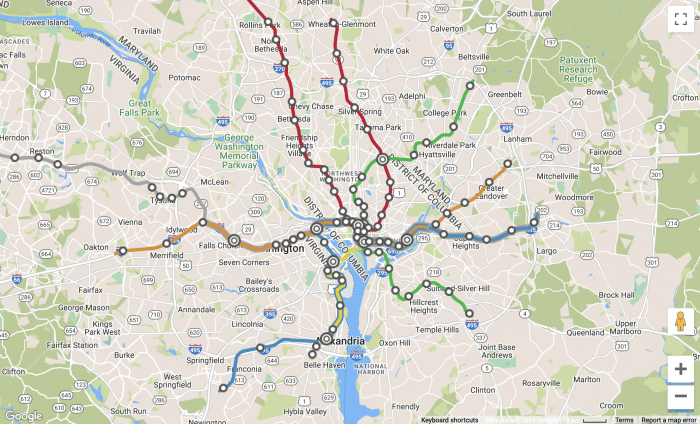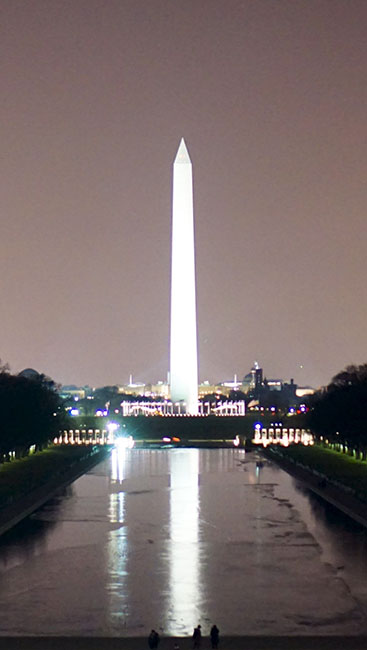Tips for Moving to Washington, D.C.: 7 Things To Know
Do you dream of living within a stone’s throw of the White House, Congress, or the National Mall? Home to the Smithsonian, a huge cherry blossom festival, and American politics, Washington, D.C. is the heart of the USA. Whether you’re moving there for work or just enjoy the hustle and bustle of this major city, there’s a lot to love about the District of Columbia.
But moving to America’s capital can seem intimidating, especially if you’re planning a long-distance move. Moving down the street from Capitol Hill doesn’t have to be hard, though.
Check out this guide for everything you need to know before making a move to the nation’s capital. Not only will we show you how to relocate to D.C., but we’ll also show you how to find the best moving companies in the area to manage every step of your move.
And if you’re looking for more info on moving to Washington DC, check out our resources on the cost of living in DC and on the DC Neighborhoods.
7 things to know about moving to Washington, D.C.
Founded in 1790, Washington, D.C. is a surprisingly small area situated between Maryland and Virginia. There’s a lot of history here, but with a population of more than 713,000 people as of 2020, D.C. is a modern, thriving city. Here’s what you need to know before planning a move there.
1. Cost of living
Not to scare you, but Washington, D.C. has some of the highest rents in the country. As of 2024, average D.C. rent on a 750-square-foot one-bedroom apartment is $2,422 per month. Rising housing costs across the country demoted D.C. as one of the top five most expensive places to rent — it’s currently the 13th most expensive U.S. city.
D.C. is a pricey place. Although rents haven’t increased as much as they have in other areas, they still fluctuate a lot. Vacancies dipped from 9.8% in 2021 to 7.9% in 2022, so it’s getting harder to find a place to rent. And the places that are available will definitely cost more. That’s just supply and demand, bud.
The good news is that some areas of the city are cheaper than others. The closer you are to the White House, the more expensive the rent. You’ll find most of the wealth in the northwest part of the city, while the opposite is the case the further southeast you go (mainly past the Anacostia River).
Downtown, Penn Quarter, Adams Morgan, Dupont Circle, and Georgetown are some of the higher-end neighborhoods that’ll provide plenty of live music and happy hours but will likely cost you over $3,000 a month in rent for a reasonably-sized apartment.
People with a tighter budget can find a decent place under $2,000 in Trinidad, Langston, Kingman Park, U-Street/Shaw, and Anacostia.
2. The job market
The D.C. unemployment rate was 5% in October 2023, which is higher than the national average. Jobs grew 2.4% from 2022 to 2023, though, so the market is steadily expanding.
The median salary is $76,908, which is higher than the national average of $59,428. The kicker, though, is that D.C. is more expensive than most U.S. cities. Sure, you’ll likely earn more in this job market, but your expenses will gobble up most of those earnings if you don’t plan your living situation carefully.
In terms of job availability, it’s no surprise that the number-one employer is the federal government. These jobs are the most in-demand right now:
- Administration
- Policy development
- Legal services
- Cybersecurity
- Consulting
- Financial services
- Communications
However, there’s a healthy demand for healthcare and hospitality workers to support Washington, D.C.’s growing population. Whether you’re a hotshot young professional looking for a lobbying gig or would rather wait tables, there’s a job for you in D.C.
3. Washington, D.C. wards and suburbs
Washington, D.C. is made up of eight wards  split into four quadrants.
split into four quadrants.
It’s incredibly important that you pay attention to which quadrant you’re in. Don’t type in 100 L St. SE into your GPS instead of 100 L St. NW or you’ll end up in a totally different part of town. Yes, being one letter off can make a difference.
Laws, zoning, trash collection, and other things are governed by which ward you live in and which of the 37 Advisory Neighborhood Commisions (ANCs) you live in. Think of the ANCs as supercharged HOAs that have the power to enact local policies and pass on your concerns to district representatives. Look up which ANC applies to your future address to see how they work with residents.
Now, if you love the D.C. area but aren’t too keen on living in the city, plenty of folks live in the D.C. suburbs instead. D.C. has some of the nicest, classiest, and most expensive suburbs in the country. Places like Arlington, Alexandria, and Chevy Chase all have average household incomes at or near six digits.
It stands to reason that renting houses or condos here will also be expensive. A piece of real estate in Alexandria, which is on the Virginia side of the Potomac River, will run you between $2,000 and $6,000 a month. Same for Chevy Chase and Arlington.
However, if you’re looking for somewhere to live on a more modest budget (and don’t mind a bit of a commute), you can look towards Bethesda, Rockville, Silver Spring, or Takoma Park. These may be a bit further from the city than the pricier neighborhoods, but many of them make up for that with convenient public transit options.
4. Transportation
Speaking of transportation, you have a lot of options for getting around D.C. Of course, they all vary in terms of time, cost, and frustration.
Driving
Driving in D.C. can be infuriating, to say the least. The problem isn’t just all the tourists visiting the Lincoln Memorial or the Washington Monument, but also the dense population in such a small area.
Washington, D.C. is notorious for rush hour traffic. In fact, D.C. drivers spend almost 2 days a year sitting in traffic.
In general, it’s a good idea to live on the same side of the Potomac and Anacostia rivers as you work. This will save you from crossing the river bridges, which serve as de facto bottlenecks for traffic.
However, there are a few ways to avoid traffic:
- Get an E-ZPass. The roads from Virginia and Maryland leading into D.C. have a lot of tolls, which is why an E-ZPass is so vital. They’ve also added a bunch of express lanes from Virginia. All drivers using the new lanes — except motorcyclists — will need an E-ZPass to skip the long waits.
- Receive transit benefits. Federal workers can receive a monthly transit benefit that pays for Metro rides and for parking at Metro stations. Other workers can take advantage of a pre-tax deduction from their salaries to pay for transit use.
- Rideshare. Services such as Commuter Connections connect people who want to rideshare.
If you plan on driving a car to work, either live close to work or buy some audiobooks to pass the time you’ll spend in traffic.
Public transportation
 If driving doesn’t sound like much fun, you’re right! Driving gives you more control over your day, but D.C.’s robust public transportation system gives you plenty of ways to avoid the hassle of driving.
If driving doesn’t sound like much fun, you’re right! Driving gives you more control over your day, but D.C.’s robust public transportation system gives you plenty of ways to avoid the hassle of driving.
Driving might be a bit of a nightmare, but D.C. consistently ranks highly for public transportation and walkability.
D.C. residents often opt for these driving alternatives:
- The D.C. Metrorail: Metrorail provides train services between 91 stations in Virginia, Maryland, and D.C. The Metro has six color-coded lines: Red, Orange, Silver, Blue, Yellow, and Green. That might sound confusing, but the system’s layout makes it possible to travel between any two stations without transferring more than once.
- The D.C. Metrobus: The Metrobus stops at 11,500 bus stops in the D.C. area. Bus stops are designated with red, white, and blue signs. It’s worth mentioning that the D.C. Metro does some funky tricks with its pricing, and it’s easy to get caught at the station with the dreaded “Insufficient Funds” warning blinking in your face. To make sure you always have an even denomination left, never have more than $20 on your Metro card at one time.
- Biking: A lot of people bike to work, too. Arlington, Silver Spring, and Bethesda are just a few of the D.C.-adjacent suburbs with convenient biking options. You can also join the Capital Bikeshare program. You can get bikes for a day, three days, a month, or a year, and have access to them 24/7. The first half hour of each trip is free, and each additional half hour incurs a fee.
5. Crime rates
Statistically speaking, D.C.’s crime rate isn’t great. Neighborhood Scout puts D.C.’s Crime index rating at a meager 4 out of 100. The violent crime rate is 8.12 people per 1,000 residents. That’s double the national average of four people per 1,000 residents.
But, as with most cities, personal caution and situational awareness matter much more than geography and some nebulous statistics. So, check out the map to see where the areas with the highest crime density are and do your best to stay out of them after midnight.
While the stats and maps may make things look pretty dire, it’s important to note that violent crime in D.C. is down significantly. The homicide rate decreased by 50% from 2023 to 2024, with an overall 3% reduction in violent crime year-over-year.
It’s pretty basic: be smart, stay out of trouble, avoid antagonizing people, and you’ll be fine. It doesn’t hurt to lock up your car and apartment, either.
6. Weather
You get all four seasons in Washington, D.C. Enjoy the crisp fall air, winter snow, springtime cherry blossoms, and summer heat in the nation’s capital. However, the winters get cold and summers can get hot, so you definitely need to plan for all types of weather.
Make sure your home has both A/C and heat. If you’re moving from a warmer climate, invest in good boots, gloves, and a winter jacket before October, when temperatures start to dip.
7. Recreation and entertainment
 Are you a history buff? Or maybe you’re in the mood for a bit of beer or nightlife? The Washington, D.C. metro area has a little bit of everything.
Are you a history buff? Or maybe you’re in the mood for a bit of beer or nightlife? The Washington, D.C. metro area has a little bit of everything.
If you’re new to D.C., you have to do all the touristy stuff first. That includes:
- The Smithsonian Museum
- The National Air and Space Museum
- The National Mall
- The U.S. Capitol
- The Washington Monument
- The Library of Congress
Once you’ve got that out of your system, start looking for more local-friendly activities. D.C. and its surrounding areas offer a wide variety of nightlife, whether you’re looking for a good meal with cocktails or just going out for drinks at the end of a long day.
Check out Tryst, a cozy bar-slash-cafe that boasts non-corporate coffee and a wide variety of vodka martinis. Or, if you’re looking for something a bit more retro-nerd-chic, check out the Board Room for a night of beer and tabletop gaming. You should also try the foodie destination, Service Bar, for cocktails and a rotating menu of dishes made entirely from local ingredients.
D.C. also has a thriving live performance scene with well-known music venues, such as Songbyrd, the Wonderland Ballroom, the U-Street Music Hall, and the 9:30 Club.
Or, if you’re in the mood for a laugh, check out the DC Improv Club (as with all improv, your results may vary).
For more of a visual overview of DC’s most iconic locales, check out this aerial tour.
How to move to Washington, D.C.
Washington, D.C. is an important city with a unique vibe. If you’ve decided to start a new life in D.C., here’s a step-by-step guide to help you relocate:
- Find the right neighborhood. D.C. has a diverse range of neighborhoods, each with its own character. Consider factors like proximity to work, schools, public transportation, and local amenities.
- Budget carefully. Cost of living is high in Washington, D.C. It can be a bit of a culture shock if you’re not used to living in a high-cost-of-living (HCOL) area, so be mindful of your budget.
- Prepare for all four seasons. If you’re only prepared for summertime, D.C.’s November chill will knock you on your feet. You can save money and prepare for the weather by shopping for off-season styles. For example, shop for swimsuits in October or winter jackets in April.
- Plan for transportation. This really depends on where you work and live. Most folks find a job first, then try to find a place with reasonable commute options. Driving in D.C. is a headache, so consider alternatives like walking, biking, or taking the Metro.
- Update your legal documents. Visit the DMV to update your driver’s license, car registration, voter registration, and any other important documents if you relocate from another state.
As important as these steps are, finding the right mover is the best first step to take. They’ll have oodles of local knowledge — plus moving tips — to help you plan the most efficient move, whether you’re relocating locally or cross-country. You can also check out our comprehensive moving checklist to help you get started and stay on track.
|
|
|
|
|
|
Finding the best Washington, D.C. movers
The mover you choose can make or break your move (sometimes literally). But you don’t have to fly blind here. moveBuddha readers consistently rate these companies as the best moving companies serving Washington, D.C.
Safeway Moving
Safeway Moving is a full-service moving company that offers:
- Long-distance moves
- Loading and unloading
- Packing and unpacking
- 30 days of free storage
- International moves
89% of users select this mover
All moves come with 30 days of free storage, so this is a great option if you need to store your stuff somewhere in the meantime. However, Safeway doesn’t offer local moves, so they’re only a good option if you’re moving long-distance or cross-country.
Mayzlin Relocation
Mayzlin Relocation is a family-owned full-service moving company that services the entire East Coast. They’re also one of our top picks for best long-distance moving companies.
They offer:
- Packing
- Military moves
- Moving consulting
- Local and long-distance moves
89% of users select this mover
Like many full-service movers, Mayzlin does require a 25% deposit, and you have to call to get a quote.
American Van Lines
American Van Lines offers some of the best pricing for last-minute full-service moves. They specialize in cross-country or international moves, storage, packing, and even custom crating for large items, like pianos. However, they require a 50% deposit and are only available in the contiguous United States.
89% of users select this mover
JK Moving
moveBuddha readers consistently rate JK Moving as one of the best full-service movers in the United States. They provide AI-powered in-home estimates, which give you the benefit of crazy-accurate estimates in just a few minutes.
89% of users select this mover
JK Moving offers white-glove service — and charges accordingly. They’re more pricey, but if you’re looking for background-checked movers and 24/7 customer support, Washingtonians rate JK Moving highly.
U-Pack
U-Pack is a DIY move option only for long-distance moves and one of the best moving container companies in the industry. They supply the storage containers (called ReloCubes) or a 28-foot trailer, and you handle the labor. Once you load the container or trailer, U-Pack relocates it to your new home or to storage.
89% of users select this mover
This is much more affordable than full-service movers and gives you the convenient option of storing your things at a facility (applies only to containers), which is ideal for anyone who needs a little flexibility. Plus, you only pay for the space you use!
PODS
PODS is another top moving container company that’s perfectly suited for DIY moves. They’re a little pricer than U-Pack, but do offer local moves, if that’s what you’re looking for. PODS delivers the container to your address, and you have as much time as you need to load it.
89% of users select this mover
When you’re ready to move, PODS returns, transports the container to your new home, and gives you time to unload. You contact them again once you’ve unloaded and they’ll pick up the POD. Easy peasy!
Word to the wise, though: Check with your local ANC or apartment building and ask about parking restrictions. You may need to get a parking permit for the PODS container in Washington, D.C., so check the rules before booking.
Budget Truck Rental
This is the least convenient option, but renting a truck from Budget Truck Rental can be the most cost-effective way to move to Washington, D.C. It’s one of the best rental truck companies in the area, offering tons of discounts and a wide range of truck types and sizes.
89% of users select this mover
You’ll have to manage the labor and transportation, but if you’re okay with spending more time and effort, this option could save you hundreds of dollars.
FAQ: Moving to Washington, D.C.
Is it a good idea to move to D.C.?
Moving to Washington, D.C. can be a great decision, depending on your personal and professional goals. It’s an urban area with lots to see and do, although it does have a high cost of living and crime rate. At the end of the day, it comes down to your future plans and preferences.
How much money do you need to live in D.C.?
It depends on your lifestyle and where you live. A single person would need to earn around $60,000 to $80,000 to live somewhat comfortably, although that’s pushing it. Most people need to earn $100,000 a year to live what you’d consider an average American lifestyle.
How is the job market in Washington, D.C.?
The job market in Washington, D.C. is generally strong, with a focus on government, political, and legal professions. However, there’s also a lot of demand for service industry jobs, healthcare, and hospitality.
There are a lot of people in D.C., though, so the market is competitive. Brush up your resume and interviewing skills to land that job!
What are the best neighborhoods to live in Washington, D.C. for families?
The most family-friendly Washington, D.C. neighborhoods are:
- Capitol Hill
- Chevy Chase
- Cleveland Park
- Palisades
- Tenleytown/American University Park
Not what you were looking for?
Check out other categories that can help you find the information you need!









